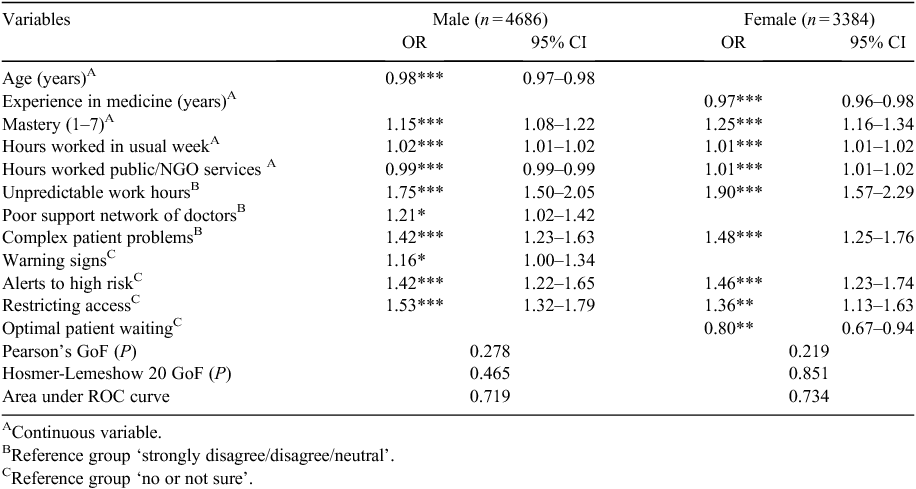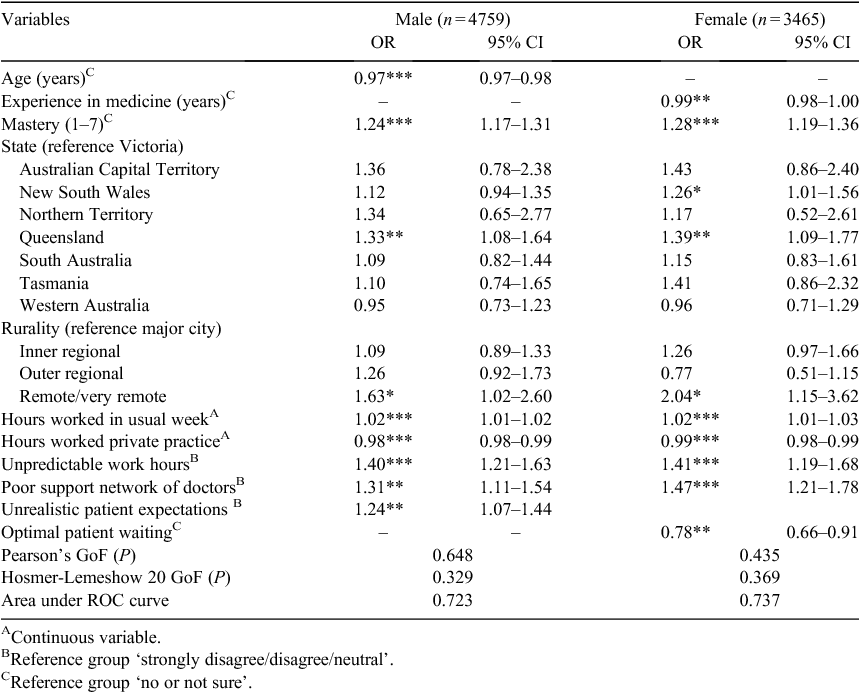Differences in risk and protective factors for workplace aggression between male and female clinical medical practitioners in Australia
Danny J. HillsSchool of Nursing and Midwifery, Faculty of Medicine, Nursing and Health Sciences, Monash University, Wellington Road, Clayton, Vic. 3800, Australia. Email: danny.hills@monash.edu
Australian Health Review 41(3) 313-320 https://doi.org/10.1071/AH16003
Submitted: 6 January 2016 Accepted: 3 May 2016 Published: 23 June 2016
Journal Compilation © AHHA 2017 Open Access CC BY-NC-ND
Abstract
Objectives The aim of the present study was to investigate differences in prevalence, as well as risk and protective factors, for exposure to workplace aggression between male and female clinicians in Australian medical practice settings.
Methods In a cross-sectional, self-report study in the third wave of the Medicine in Australia: Balancing Employment and Life survey (2010–11), 16 327 medical practitioners were sampled, with 9449 (57.9%) respondents working in clinical practice. Using backward stepwise elimination, parsimonious logistic regression models were developed for exposure to aggression from external (patients, patients’ relatives or carers and others) and internal (co-workers) sources in the previous 12 months.
Results Overall, greater proportions of female than male clinicians experienced aggression from external (P < 0.001) and internal (P < 0.01) sources in the previous 12 months. However, when stratified by doctor type, greater proportions of male than female general practitioners (GPs) and GP registrars experienced external aggression (P < 0.05), whereas greater proportions of female than male specialists experienced external (P < 0.01) and internal (P < 0.01) aggression. In logistic regression models, differences were identified in relation to age for males and experience working in medicine for females with external and internal aggression; working in New South Wales (vs Victoria) and internal aggression for females; a poor medical support network and external aggression, and perceived unrealistic patient expectations with internal aggression for males; warning signs in reception and waiting areas with external aggression for males; and optimised patient waiting conditions with external and internal aggression for females.
Conclusions Differences in risk and protective factors for exposure to workplace aggression between male and female clinicians, including in relation to state and rural location, need to be considered in the development and implementation of efforts to prevent and minimise workplace aggression in medical practice settings.
What is known about the topic? Workplace aggression is prevalent in clinical medical settings, but there are conflicting reports about sex-based differences in the extent of exposure, and little evidence on differences in risk and protective factors for exposure to workplace aggression.
What does this paper add? Differences in workplace aggression exposure rates between male and female clinicians are highlighted, including when stratified by doctor type. New evidence is reported on differences and similarities in key personal, professional and work-related factors associated with exposure to external and internal aggression.
What are the implications for practitioners? In developing strategies for the prevention and minimisation of workplace aggression, consideration must be given to differences between male and female clinicians, including with regard to personality, age and professional experience, as well as work locations, conditions and settings, as risk or protective factors for exposure to aggression in medical work.
Additional keywords: aggression, gender, medicine, physician.
Introduction
Workplace aggression remains a major concern in health care work. Yet, although there is ample evidence of the prevalence, predictors and effects of workplace aggression in nursing, it has been less studied in medicine.1,2 In Australian studies, workplace aggression has been identified as an intrinsic part of medical work, with up to 71% of clinicians reporting exposure to non-physical forms and up to 32% of reporting exposure to physical forms in the previous 12 months, with most aggression emanating from patients and their family or carers.3–5 High rates of internal (co-worker) aggression have also been reported in Australian medical settings.3,6 In addition, there is a growing understanding of key personal, work and patient factors that may increase the risk of exposure to aggression in medical work,1,7 and the negative effect it may have on clinician health and well being,8 workforce participation decisions9,10 and the quality of medical care.11,12
The risk of workplace aggression is recognised as being higher in younger and primarily hospital-based clinicians.3,13,14 To date, however, the body of evidence is equivocal, even contradictory, with regard to differences between males and females in exposure to non-physical1,3,15 and physical forms of aggression.1,3,16 It has also been argued that there is a need to more clearly understand these differences in risk and protective factors for exposure to workplace aggression, both to facilitate an understanding of differences in effect and to better target prevention and minimisation measures.1,15,16 Therefore, the aim of the present study was to determine the extent of differences between male and female clinicians in exposure to aggression from sources external or internal to the workplace, and the risk and protective factors for external and internal aggression in a large sample of Australian clinical medical practitioners.
Methods
The present cross-sectional study of workplace aggression in Australian clinical medical practice was undertaken in the third wave of the Medicine in Australia: Balancing Employment and Life (MABEL) longitudinal survey.3,7–9,17 Data were collected between March 2010 and June 2011, with 16 327 (27.6%) medical practitioners sampled from the Medical Directory of Australia (MDA).7,8 The conduct of the study was approved by The University of Melbourne Faculty of Business and Economics Human Ethics Advisory Group and the Monash University Standing Committee on Ethics in Research Involving Humans.
Variables
The MABEL questionnaires for each of the four Australian ‘doctor types’ (general practitioners (GPs) and GP registrars, specialists, specialists in training and hospital non-specialists) included many common demographic and other profile variables, including sex, age, international medical graduate (IMG) status and location by state and Australian Standard Geographic Classification (ASGC) of remoteness.18 Personal control orientation, ‘…the extent to which one regards one’s life-chances as being under one’s own control in contrast to being fatalistically ruled’,19 was measured with a revalidated version of the Pearlin Mastery Scale, summed from 1 to 7 on a continuous scale, with higher scores indicating greater external control orientation.7
Workplace aggression was defined as follows:
‘…any workplace aggression directed toward you in the last 12 months whilst you were working in medicine (i.e. any circumstance or location in which you performed your role as a medical practitioner), including:
• Verbal or written abuse, threats, intimidation or harassment – such as ridicule, abusive email, racism, bullying, contemptuous treatment and non-physical threats or intimidation
• Physical threats, intimidation, harassment or violence – such as a raised hand or object, unwanted touching, damage to property and sexual or other physical assault.3
The frequencies of verbal or written and physical aggression experienced from three external sources (patients, patients’ relatives or carers and others external to the workplace) and from internal sources (co-workers) in the previous 12 months were estimated with five-point ordinal response scales, namely ‘Frequently’ (once or more each week), ‘Often’ (a few times each month), ‘Occasionally’ (a few times each 6 months), ‘Infrequently’ (a few times in 12 months) and ‘Not at all’. Most clinicians reported experiencing aggression ‘Infrequently’ or ‘Not at all’.3 The aggression prevalence variables were transformed into binary variables (Yes/No), then aggregated into two items representing whether or not clinicians experienced aggression from external or internal sources.
Other items included that had been identified previously as associated with workplace aggression exposure related to work hours, conditions and resources, and perceived patient characteristics (Box 1).7 The variables ‘total hours worked’ and researcher-developed variables for total hours in the most recent usual week in ‘public and non-government- organisation (NGO) sector work’, ‘private sector work’ and ‘residential and aged care sector work’ were imputed from questionnaire items requesting self-reported hours worked in the most recent usual week, excluding on-call work, and hours worked in the most recent usual week in 10 practice setting categories. A small number of outliers (greater than 120 h per week) were excluded from analyses.7 Also included were the extent to which respondents agreed or disagreed with four work and patient items (‘I have a poor support network of other doctors like me’, ‘It is difficult to take time off when I want to’, ‘My patients have unrealistic expectations about how I can help them’, ‘The majority of my patients have complex health and social problems’) on a five-point ordinal-response scale (0 = strongly disagree; 1 = disagree; 2 = neutral; 3 = agree; 4 = strongly agree). Each item was dichotomised about the median to facilitate analyses.
| Box 1. Work hours, conditions and resources, and perceived patient characteristics variables |
|
AContinuous scale. BBinary scale (0 = no, 1 = yes). COrdinal scale (0 = strongly disagree; 1 = disagree; 2 = neutral; 3 = agree; 4 = strongly agree). |
For the workplace aggression prevention and minimisation variables (Box 2), point-prevalence estimates were obtained by respondents indicating ‘Yes’, ‘Unsure’ or ‘No’ as to whether each strategy had been implemented in their main workplace. A ‘Not Applicable’ option was provided for item 12 only but, because of the large proportion of missing (8.1%) and not applicable (12.0%) responses, this item was not retained. The remaining items were transformed into binary variables (Yes/No or unsure) to facilitate analyses.7
| Box 2. Aggression prevention and minimisation actions implemented in the main workplace |
|
Statistical analyses
The respondent profile was compared with the 2010 MDA clinician profile using the Kruskal–Wallis equality of populations rank test (corrected for tied ranks) for categorical variables (doctor type, sex, state and ASGC location) and the independent t-test for mean age.3 Exposure to workplace aggression from external and internal sources was stratified by sex and, in addition, by ‘doctor type’. Prevalence rates were determined with 95% confidence intervals (CI; exact binomial). Differences in exposure prevalence were determined with the χ2 test.
Logistic regression modelling was performed to identify statistically significant associates of exposure to external and internal aggression for male and female clinicians, controlling for doctor type. All variables were initially entered into each model. Using backward stepwise elimination (retention criterion P < 0.05), the most parsimonious models were determined. Each model was assessed for goodness of fit (Pearson χ2 and Hosmer–Lemeshow χ2 with 20 equal groups) and discrimination (area under the receiver operating characteristic (ROC) curve). Statistical analyses were conducted using Stata version 13 (StataCorp).
Results
Of the 16 327 medical practitioners sampled, 57.9% (9449) responded and indicated currency of clinical practice in Australia, and were found to be broadly representative of the Australian clinical medical workforce.3 Frequencies and proportions of categorical profile and work variables are summarised in Table 1, continuous profile and work variables are summarised in Table 2, and binary workplace aggression variables are summarised in Table 3.3,7–9,17
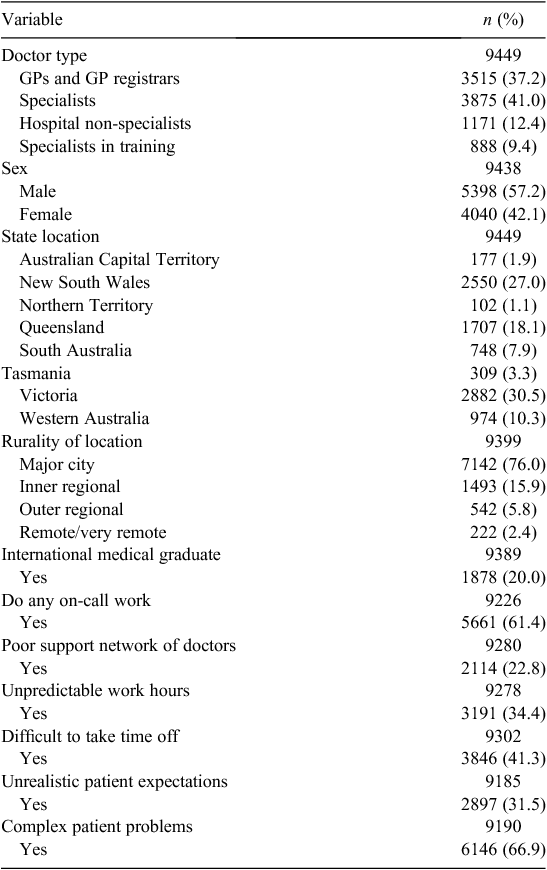
|
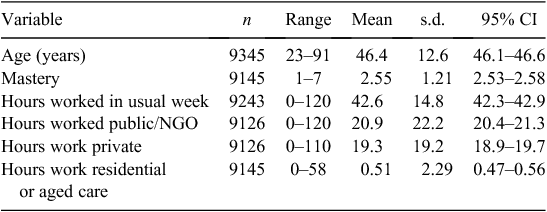
|
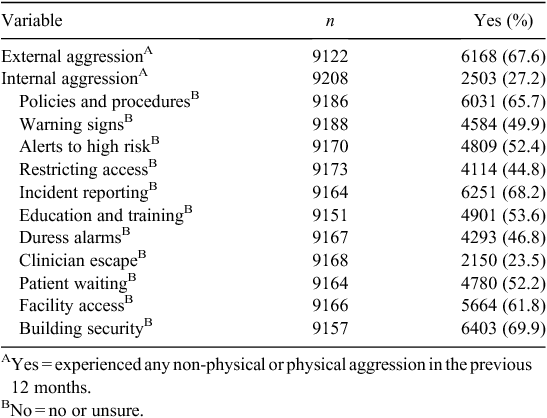
|
Overall, female clinicians reported higher rates of exposure to aggression from both external and internal sources in the previous 12 months. There was a significant difference (P < 0.001) between overall rates of exposure to workplace aggression from external sources, with to 69.6% (95% CI 68.1–71.0; n = 3909) of female clinicians compared with 66.1% (95% CI 64.8–67.4; n = 5203) of male clinicians exposed. There was also a significant difference (P < 0.01) between overall rates of exposure from internal sources, with 28.9% (95% CI 27.5–30.3; n = 3948) of female clinicians compared with 25.9% (95% CI 24.7–27.1; n = 5250) of male clinicians exposed. The patterns of exposure were found to be more complex, however, when stratified by doctor type, as shown in Fig. 1 (external aggression) and Fig. 2 (internal aggression). Significant differences were found only in higher rates for male compared with female GPs and GP registrars exposed to external aggression (P < 0.05), and higher rates for female compared with male specialists exposed to external and internal aggression (P < 0.01).

|
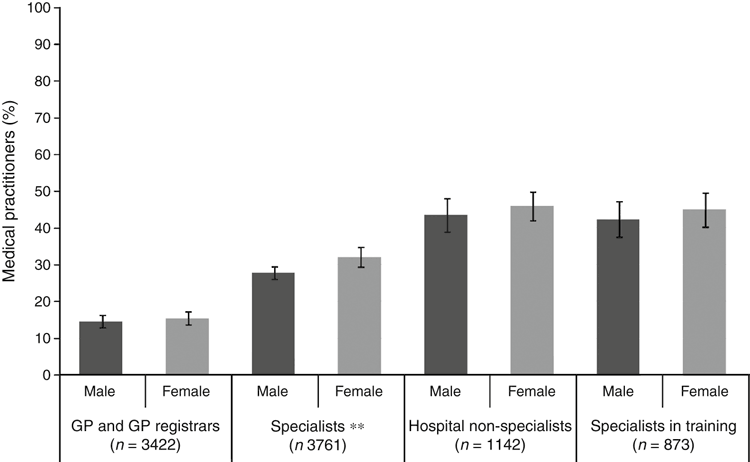
|
The outcomes of logistic regression modelling are summarised in Table 4 (exposure to workplace aggression from external sources) and Table 5 (exposure to workplace aggression from internal sources). Only those variables retained in the final models are shown. The models were found to be a good fit to the data and demonstrated adequate discrimination, with all areas under the ROC curves >0.7.20 Although there were many similarities between the regression models for male and female clinicians, some differences are apparent.
Discussion
The results of the present study expand the existing evidence base on exposure to workplace aggression in medical practice settings.3–5,21,22 As identified previously,3 female medical clinicians are more vulnerable to experiencing workplace aggression from all sources in Australia than males overall. However, when stratified by doctor type, higher rates of external and internal aggression were detected for female than male specialists only. Perhaps because of their gender and their relatively younger age compared with their male counterparts (t (3837) = 15.72, P < 0.001), female specialists are more exposed to aggression from patients, carers or others and from their co-workers. In contrast, although female GPs and GP registrars were younger than their males counterparts (t (3475) = 18.06, P < 0.001), male GPs reported higher rates of external aggression. This may reflect the increasing number of female GPs, more of whom work part-time than male GPs.23 It may also reflect a greater propensity for, or readiness of, male GPs and GP registrars to engage with aggressive patients, carers and other people, or may reflect practice policies of directing more challenging or potentially challenging patients to male clinicians.
Consistent with the literature was the relative vulnerability of hospital-based and younger or less-experienced medical clinicians to workplace aggression.1,3,5,7,21,22 For hospital non-specialists and specialists in training, similarly very high rates of exposure to external and internal aggression were reported by both males and females. Controlling for doctor type, greater age for males and greater experience working in medicine for females were consistently negatively associated with external and internal aggression exposure. Consistent with previous findings,7 for both male and female clinicians, increasing external control orientation was similarly positively associated with experiencing external and internal aggression in the previous 12 months. In addition to clinician gender, personality characteristics, age and medical work experience must be key considerations in developing prevention and minimisation strategies for exposure to external and internal aggression.
Also reflecting previous results,7 working in Queensland (vs Victoria) was found to be a risk for experiencing internal aggression for both males and females, controlling for all other variables. However, for females only, working in New South Wales (vs Victoria) was additionally positively associated with exposure to internal aggression. Working in rural and remote locations, compared with working in major cities, was strongly associated with experiencing internal aggression in the previous 12 months for both male and female clinicians. This somewhat reflects previous results,7 but other studies have primarily focused on exposure to patient aggression. Clearly, location of work needs to be an important consideration for policy and practice, both at the state and local level, in the prevention and minimisation of exposure to workplace aggression in medical settings.
Increasing hours worked in the most recent usual week was weakly associated with external and internal aggression for both male and female clinicians, whereas a stronger association was detected for clinicians reporting that their hours of work were unpredictable, especially with regard to external aggression, which somewhat reflects the literature.5,7,21,24,25 In novel findings, increasing hours worked in the public and NGO sector were weakly associated with external aggression, negatively for males but positively for females, whereas for internal aggression increasing hours worked in private practice for both males and females was weakly protective for aggression exposure. In addition, for male clinicians, having a poor support network of other doctors was positively associated with external aggression, whereas for both male and female clinicians, having a poor support network of other doctors was positively associated with internal aggression. As highlighted previously, in work that can already be stressful, a felt absence of support networks may further compromise coping and control capacities, including with regard to effectively minimising challenging encounters with others.7
The demands of patient care are perhaps exemplified in the concerns of clinicians about many of their patients’ complex health and social problems, and unrealistic care expectations. Clinicians who felt that the majority of their patients have complex health and social problems, compared with those who did not, were at a more than 40% increased risk of external aggression. For male clinicians only, perceiving that most of their patients have unrealistic expectations about how they can be helped, compared with those who did not, was associated with internal aggression. Both perceptions may be reflective of stressful work conditions associated with clinical practice in lower socioeconomic status (SES) communities.7 In other studies,4,26 medical work in lower SES communities has been found to be associated with workplace aggression.4,26
Four of 11 measures for preventing and minimising aggression in the main place of work remained as associates of external aggression in the regression models, with one remaining for internal aggression. For males, warning signs in reception and patient and public waiting areas were associated with external aggression. For both males and females, the use of alerts to high-risk patients and the practice of restricting or withdrawing access to services for aggressive people were associated with external aggression. Each of these prevention and minimisation measures has little or no evidence of efficacy, despite some support in theory and expert opinion,1 but may be more likely used as a reactive response to past experiences or pre-existing high rates of workplace aggression.7 For female clinicians only, optimised lighting, noise levels, comfort and waiting times in patient and public waiting areas were negatively associated with exposure to external and internal aggression. Stress-inducing environmental conditions may contribute to an elevation in the risk of aggressive behaviour, so the presence of optimised waiting conditions may be reflective of a more service-oriented practice setting, one that is more attuned to the needs of patients and staff.7 Why this factor may be protective only for female clinicians is unclear.
Although this report has focused on sex-based differences in the prevalence of and risk and protective factors for exposure to workplace aggression, the role of gender needs to be considered. It has been argued that men who work in the health sector may have a different ‘masculinity’ from men who work in other industries, demonstrating, for example, more caring and less aggressive traits, and this may underpin the relatively fewer differences between male and female clinicians with regard to overall exposure rates to workplace aggression.15 This perspective may also explain, in part, some of the differences identified in the present study, such as in the relative vulnerability to aggression exposure of females in the specialities, where gender inequity may be more prominent.6 The fact remains, however, that the prevalence of workplace aggression in Australian clinical medical practice is unacceptably high for both male and female clinicians. Furthermore, there are several other important risk and protective factors (such as age, control orientation, practice location and work conditions) that need to be considered in developing strategies to prevent and minimise the likelihood and consequences of this concerning work health and safety issue.
Limitations of the present study include that self-report data were obtained from a cross-section of medical practitioners. This may affect the reliability of some responses and no attributions of causality can be made. Sampling biases were minimal because the profile of respondents was broadly representative of the population. Self-selection bias by those who had experienced aggression was also likely minimal because the aggression items were a small component of the MABEL questionnaires. Most items were concerned with estimates of frequency or perceptions. Although a clear definition of workplace aggression was provided, survey responses were subject to clinicians’ own perceptions of the meaning of the questionnaire terms used and of experiencing the types, sources and relative frequencies of aggression. To minimise recall bias and maximise response accuracy, however, questionnaire items elicited estimates of aggression exposure in frequency ranges.27 In addition, reporting of aggression prevention and minimisation measures relied on clinician knowledge of their presence or otherwise and the full range of measures applied in practice settings may not have been captured. Similarly, other important aspects of personality, work conditions and work resources may not have been included in the study.
Conclusion
The results of the present study highlight important similarities and differences in personal, professional and work factors associated with workplace aggression experienced by male and female clinical medical practitioners. While reaffirming some earlier results, as described above, the study has shed new light on this important work health and safety concern, particularly with regard to differential rates of exposure to internal and external aggression for male and female clinicians. In addition, state-based risks for aggression exposure and the increased risk for internal (co-worker) aggression in remote and very remote compared with metropolitan settings have been highlighted. The results provide evidence for legislators, policy makers, health services and the medical profession to inform the development of strategies that may more effectively prevent and minimise the likelihood and consequences of workplace aggression. These strategies need to take into account clinician gender, personality, age and professional experience, patient complexity and expectations, as well as medical work locations, conditions and settings. It is also expected that the results of the present study will provide an impetus for further inquiry into gender-based differences in workplace aggression experiences and its mitigation in clinical medical practice settings. Research efforts to further strengthen the evidence base on interventions for preventing and minimising workplace aggression in medical settings are also required.
Competing interests
None declared.
Acknowledgements
The Medicine in Australia: Balancing Employment and Life (MABEL) study was supported by a National Health and Medical Research Council Health Services Research Grant (454799) and the former Commonwealth Department of Health and Ageing in Australia. The author thanks the medical practitioners who gave their valuable time to participate in this study.
References
[1] Hills D, Joyce C. A review of research on the prevalence, antecedents, consequences and prevention of workplace aggression in clinical medical practice. Aggress Violent Behav 2013; 18 554–69.| A review of research on the prevalence, antecedents, consequences and prevention of workplace aggression in clinical medical practice.Crossref | GoogleScholarGoogle Scholar |
[2] Gerberich SG, Church TR, McGovern PM, Hansen HD, Nachreiner NM, Geisser MS, Ryan AD, Mongin SJ, Watt GD. An epidemiological study of the magnitude and consequences of work related violence: the Minnesota nurses’ study. Occup Environ Med 2004; 61 495–503.
| An epidemiological study of the magnitude and consequences of work related violence: the Minnesota nurses’ study.Crossref | GoogleScholarGoogle Scholar | 1:STN:280:DC%2BD2c3ltF2msA%3D%3D&md5=6059f344cfcc0dd6b0d3e6bea66e1dbbCAS | 15150388PubMed |
[3] Hills D, Joyce C, Humphreys J. A national study of workplace aggression in Australian clinical medical practice. Med J Aust 2012; 197 336–40.
| A national study of workplace aggression in Australian clinical medical practice.Crossref | GoogleScholarGoogle Scholar | 22994831PubMed |
[4] Magin P, Adams J, Sibbritt D, Joy E, Ireland M. Experiences of occupational violence in Australian urban general practice: A cross-sectional study of GPs. Med J Aust 2005; 183 352–6.
| 16201952PubMed |
[5] Forrest LE, Herath PM, McRae IS, Parker RM. A national survey of general practitioners’ experiences of patient-initiated aggression in Australia. Med J Aust 2011; 194 605–8.
| 21644878PubMed |
[6] Expert Advisory Group on Discrimination Bullying and Sexual Harassment. Report to the RACS: draft. Melbourne: Royal Australasian College of Surgeons; 2015. Available at: https://www.surgeons.org/media/22045685/EAG-Report-to-RACS-Draft-08-Sept-2015.pdf [verified 6 January 2015].
[7] Hills DJ, Joyce CM. Personal, professional, and work factors associated with Australian clinical medical practitioners’ experiences of workplace aggression. Ann Occup Hyg 2013; 57 898–912.
| Personal, professional, and work factors associated with Australian clinical medical practitioners’ experiences of workplace aggression.Crossref | GoogleScholarGoogle Scholar | 23519949PubMed |
[8] Hills D, Joyce C. Workplace aggression in clinical medical practice: associations with job satisfaction, life satisfaction and self-rated health. Med J Aust 2014; 201 535–40.
| Workplace aggression in clinical medical practice: associations with job satisfaction, life satisfaction and self-rated health.Crossref | GoogleScholarGoogle Scholar | 25358579PubMed |
[9] Hills D. Associations between Australian clinical medical practitioner exposure to workplace aggression and workforce participation intentions. Aust Health Rev 2015; 40 36–42.
| Associations between Australian clinical medical practitioner exposure to workplace aggression and workforce participation intentions.Crossref | GoogleScholarGoogle Scholar |
[10] Heponiemi T, Kouvonen A, Virtanen M, Vanska J, Elovainio M. The prospective effects of workplace violence on physicians’ job satisfaction and turnover intentions: the buffering effect of job control. BMC Health Serv Res 2014; 14 19
| The prospective effects of workplace violence on physicians’ job satisfaction and turnover intentions: the buffering effect of job control.Crossref | GoogleScholarGoogle Scholar | 24438449PubMed |
[11] Arnetz JE, Arnetz BB. Violence toward health care staff and possible effects on the quality of patient care. Soc Sci Med 2001; 52 417–27.
| Violence toward health care staff and possible effects on the quality of patient care.Crossref | GoogleScholarGoogle Scholar | 1:STN:280:DC%2BD3M3mtFyktw%3D%3D&md5=afba8afecb30b08aa4b3c99b3906be2eCAS | 11330776PubMed |
[12] Paice E, Smith D. Bullying of trainee doctors is a patient safety issue. Clin Teach 2009; 6 13–7.
| Bullying of trainee doctors is a patient safety issue.Crossref | GoogleScholarGoogle Scholar |
[13] Buckley P. Violence at work 2013/14: findings from the crime survey for England and Wales. London: Health Service Executive; 2014. Available at: http://www.hse.gov.uk/statistics/causinj/violence/violence-at-work.pdf [verified 6 January 2015].
[14] Estrada F, Nilsson A, Jerre K, Wikman S. Violence at work: the emergence of a social problem. J Scand Stud Criminol Crime Prev 2010; 11 46–65.
| Violence at work: the emergence of a social problem.Crossref | GoogleScholarGoogle Scholar |
[15] Guay S, Goncalves J, Jarvis J. Verbal violence in the workplace according to victims’ sex: a systematic review of the literature. Aggress Violent Behav 2014; 19 572–8.
| Verbal violence in the workplace according to victims’ sex: a systematic review of the literature.Crossref | GoogleScholarGoogle Scholar |
[16] Guay S, Goncalves J, Jarvis J. A systematic review of exposure to physical violence across occupational domains according to victims’ sex. Aggress Violent Behav 2015; 25 133–41.
| A systematic review of exposure to physical violence across occupational domains according to victims’ sex.Crossref | GoogleScholarGoogle Scholar |
[17] Hills D, Joyce C, Humphreys J. Workplace aggression prevention and minimisation in Australian clinical medical practice settings: a national study. Aust Health Rev 2013; 37 607–13.
| Workplace aggression prevention and minimisation in Australian clinical medical practice settings: a national study.Crossref | GoogleScholarGoogle Scholar | 24120266PubMed |
[18] Australian Institute of Health and Welfare (AIHW). Rural, regional and remote health: a guide to remoteness classifications. Rural health series no. 4, catalogue no. PHE 53. Canberra: AIHW; 2004. Available at: http://www.aihw.gov.au/WorkArea/DownloadAsset.aspx?id=6442459567 [verified 6 January 2015].
[19] Pearlin LI, Schooler C. The structure of coping. J Health Soc Behav 1978; 19 2–21.
| The structure of coping.Crossref | GoogleScholarGoogle Scholar | 1:STN:280:DyaE1c7nt1WnsA%3D%3D&md5=39386b42ccdb0ba5359c1c1d90fbae1fCAS | 649936PubMed |
[20] Hosmer DW, Lemeshow S. Applied logistic regression. 2nd edn. New York: John Wiley & Sons; 2004.
[21] Koritsas S, Coles J, Boyle M, Stanley J. Prevalence and predictors of occupational violence and aggression towards GPs: a cross-sectional study. Br J Gen Pract 2007; 57 967–70.
| Prevalence and predictors of occupational violence and aggression towards GPs: a cross-sectional study.Crossref | GoogleScholarGoogle Scholar | 18252072PubMed |
[22] Tolhurst H, Baker L, Murray G, Bell P, Sutton A, Dean S. Rural general practitioner experience of work-related violence in Australia. Aust J Rural Health 2003; 11 231–6.
| 14641220PubMed |
[23] Australian Medical Workforce Advisory Committee. The general practice workforce in Australia: supply and requirements to 2013. Sydney: Australian Medical Workforce Advisory Committee; 2005. Available at: https://www.hwa.gov.au/sites/uploads/The general practice workforce in Australia.pdf [verified 6 January 2015].
[24] Magin PJ, May J, McElduff P, Goode SM, Adams J, Cotter GL. Occupational violence in general practice: a whole-of-practice problem. Results of a cross-sectional study. Aust Health Rev 2011; 35 75–80.
| Occupational violence in general practice: a whole-of-practice problem. Results of a cross-sectional study.Crossref | GoogleScholarGoogle Scholar | 21367335PubMed |
[25] Hodgson MJ, Reed R, Craig T, Murphy F, Lehmann L, Belton L, Warren N. Violence in healthcare facilities: lessons from the veterans health administration. J Occup Environ Med 2004; 46 1158–65.
| Violence in healthcare facilities: lessons from the veterans health administration.Crossref | GoogleScholarGoogle Scholar | 15534503PubMed |
[26] Saeki K, Okamoto N, Tomioka K, Obayashi K, Nishioka H, Ohara K, Kurumatani N. Work-related aggression and violence committed by patients and its psychological influence on doctors. J Occup Health 2011; 53 356–64.
| Work-related aggression and violence committed by patients and its psychological influence on doctors.Crossref | GoogleScholarGoogle Scholar | 21828959PubMed |
[27] Dillman DA, Smyth JD, Christian LM. Internet, mail and mixed mode surveys: The tailored design method. 3rd edn. Hoboken: John Wiley & Sons; 2009.


